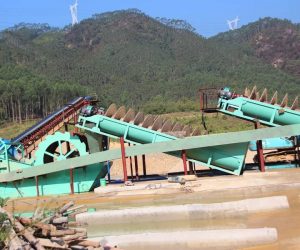A Comprehensive Guide to The Diabase Sand Making Process
Diabase is a type of common igneous rock. It is widely used in construction, roads, and other industrial applications due to its wear-resistant properties. The diabase’s formation originates from the cooling of magma deep in the Earth’s crust, usually presenting a delicate crystal structure. The diabase crushing into sand involves multiple steps, from mining the raw stone to screening and cleaning the final product. The following will provide a detailed introduction to this process.
1. Mining of diabase
The first step in mining diabase is to choose a suitable mining area. Diabase usually exists as a large-scale rock mass, and consider the following aspects during the mining process
- Mining area selection: When selecting a mining area, it is necessary to evaluate the reserves, quality, and feasibility of mining diabase. Usually, geological conditions, transportation convenience, and environmental impact in mining areas are important considerations.
- Equipment preparation: Mining diabase usually requires large equipment like excavators, shovels, and blasting equipment. Excavators are responsible for excavating and transporting rocks, while shovels are for transportation.
- Mining method: Diabase mining usually adopts open-pit or underground mining. Open pit mining is the most common method, which involves splitting rocks through drilling, blasting, and using mechanical equipment for transportation.
2. Primary crushing
After the extraction of diabase, primary crushing is to break down large rocks into smaller particles.
- Jaw crusher: The Jaw crusher is the essential equipment for primary crushing, which applies pressure to rocks by moving jaws up and down to crush them. The advantage of a jaw crusher is its strong processing capacity and wide adaptability, which can handle raw stones of various sizes.
- Crushing process: The rock enters the crusher through the feeding port and materials are crushed into smaller particles under the pressure of the moving jaw. The products after primary crushing are usually not fine enough and require further processing.
3. Secondary crushing
After primary crushing, diabase particles usually require secondary crushing to obtain smaller particles and sand. The equipment used in this stage includes
- Cone crusher: Cone crusher is an efficient secondary crushing equipment that crushes materials through a rotating cone crushing head. It can produce uniform particle sizes and is suitable for sand production.
- Impact crusher: The impact crusher uses a high-speed rotating rotor and impact plate to crush diabase materials into sand. This equipment is particularly suitable for producing fine sand, and the finished product has a good particle size.
4. Screening
The crushed diabase particles need to be sieved to separate particles of different sizes. This process mainly uses the following equipment
- Vibrating screen: The vibration screen separates materials into layers through vibration and screens out smaller particles. Usually, vibrating screens have multiple layers of screen meshes that can simultaneously screen out products of different particle sizes.
- Screening process: The crushed material is through a vibration screen into different sizes, commonly classified into coarse sand, medium sand, and fine sand. According to the requirements, select different sand particle sizes for subsequent processing.
5. Cleaning
Cleaning is an essential step in improving the quality of sand. The cleaning process can remove soil, impurities, and small particles from the sand. The cleaning equipment includes
- Sand washing machine: The sand washing machine uses water flow and mechanical action to wash away impurities in the sand. Sand washing machines usually adopt a spiral or wheel bucket design, which can effectively improve the purity of sand.
- Cleaning process: Sand and water in a sand washing machine, and through mechanical stirring and flushing, soil, and impurities are separated to obtain clean sand.
6. Storage and transportation
The final product sand needs to be stored. This process includes the following aspects
- Storage: The cleaned sand is usually stored in a dedicated yard for subsequent transportation and sales. Attention should be paid to preventing sand from getting damp and contaminated during storage.
- Transportation: Sand is usually transported in bulk using dump trucks or trucks to transport the final product to customers or construction sites. During transportation, attention should be paid to avoiding sand loss and pollution.
7. The application of sand
Processed diabase sand has excellent physical and chemical properties and is widely used in multiple fields
- Architecture: Diabase sand can be used as an aggregate for concrete and mortar, providing good strength and durability.
- Road construction: In road construction, diabase sand is used for roadbed and surface paving, which can provide good stability and compressive strength.
- Decoration: Fine sand can also be used for gardening and landscape design, providing beautiful decorative materials for gardens, fish ponds, etc.
- Industrial use: Diabase sand has wide applications in glass manufacturing, casting, and other industrial areas. It is popular due to its high wear resistance.

conclusion
The sand-making process from diabase is complex and systematic, and every step from mining to the final product is crucial. Through reasonable equipment selection and scientific process flow, diabase can be effectively converted into high-quality sand to meet the needs of the construction and industrial fields. This process not only improves the utilization of resources but also provides a solid foundation for the development of various industries. With the advancement of technology and the strengthening of environmental awareness, the production of diabase sand in the future will pay more attention to sustainable development and rational utilization of resources.
Eastman is a professional mining equipment manufacturer with 38 years of rich experience in the mining construction industry. We can also provide lab equipment. Welcome to consult our professional team to get factory prices. According to your situation and product requirements, we will design a complete sand-crushing production line flow chart and provide an accurate quotation.







